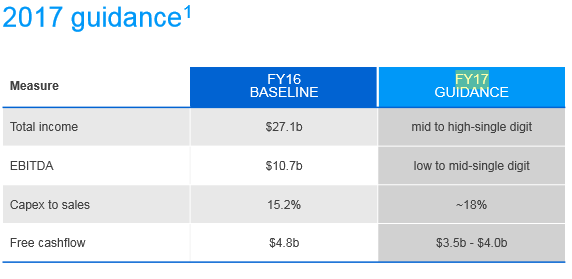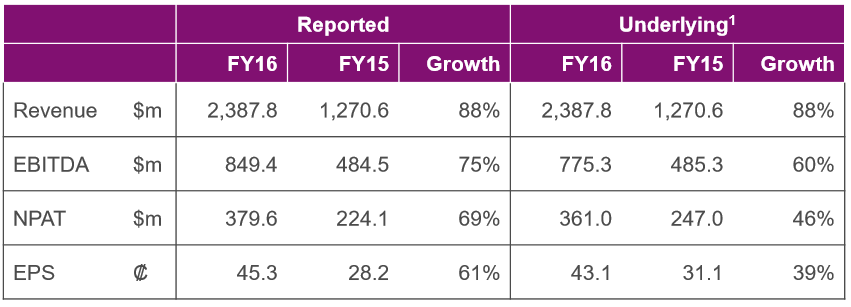The Australian telecom sector has witnessed stellar growth over the last few years. Increased connectivity has led to a sharp rise in the usage of telecommunications services, which has led to intense industry competition; a big positive for consumers. Although revenue derived from wireless services has witnessed sharp growth, driven by the rising volume for mobile data usage and greater mobile connectivity, it has been partially offset by the decline in revenue from fixed-line services. Further, the competitive environment is steaming up and therefore brings a lot of pressure in the sector.
To understand the growth story of the telecommunication industry in Australia, let’s analyse the two major telecom companies operating out of Australia and quickly take a look from the industry perspective.
Telstra Corporation Limited (ASX: TLS)
Founded in 1975, Telstra Corporation Limited is the largest telecommunication and media company in Australia, which offers a range of communication services and builds market voice and telecommunications networks, internet access, mobile, pay television and other entertainment products. Headquartered in Melbourne, Australia, the company has built the country’s largest fully integrated IP network and is the most reliable national mobile network in Australia.

2017 Guidance (Source: Company reports)
As seen from the above, TLS revenue jumped up by 3.2 percent while NPAT has been up 35.9 percent and EPS has been up 37.4 percent. The company announced for full year dividends of 31 cents per share. On the other side, EBITDA was down by 0.6 percent and the fixed voice revenue also witnessed a drop. Further, the company expects to have a lower than expected EPS growth for FY17. The stock has fallen 11.65% in last three months (as at October 14, 2016).
TPG Telecom Limited (ASX: TPM)
TPG Telecom Limited, headquartered in New South Wales, Australia was incorporated in 2008 from the merger between Total Peripherals Group and SP Telemedia. In addition, TPG acquired AAPT in February 2014 thereby adding inter capital fiber optic network to its assets. The company provides communication services such as NBN, Ethernet and fiber optic broadband access, Internet Protocol Television and telephony services throughout the country to a varied set of users comprising from domestic, government to large corporations. TPG also owns end-to-end infrastructure and a submarine cable which connects Australia and Guam with an onward connectivity to Japan and the US.

Full year FY-16 results summary (Source: Company reports)
TPM witnessed a revenue rise of 88 percent (reported) with NPAT growth of 69 percent (reported) and EPS up 61 percent. The company’s EBITDA also surged by 75 percent. On the other hand, the company has given a softness in FY17 outlook with moderate earnings growth and high capex owing to international capacity purchases and fibre rollout capex. The stock has fallen 28.98% in the last six months (as at October 14, 2016).
The telecommunication sector has witnessed solid growth registered over the last few years, however, the forecast for the future based on the industry outlook may not be overwhelming. We can witness sustained growth and acquisitions over the next couple of years as the industry consolidates but the future is still a little hazy. S&P/ASX 200 Telecomms (INDEXASX: XTJ) is down 15.13% in last three months (as at October 17, 2016) while S&P/ASX 200 (INDEXASX: XJO) has fallen only 0.61%.
Disclaimer
The advice given by Kalkine Pty Ltd and provided on this website is general information only and it does not take into account your investment objectives, financial situation or needs. You should therefore consider whether the advice is appropriate to your investment objectives, financial situation and needs before acting upon it. You should seek advice from a financial adviser, stockbroker or other professional (including taxation and legal advice) as necessary before acting on any advice. Not all investments are appropriate for all people. Kalkine.com.au and associated pages are published by Kalkine Pty Ltd ABN 34 154 808 312 (Australian Financial Services License Number 425376).The information on this website has been prepared from a wide variety of sources, which Kalkine Pty Ltd, to the best of its knowledge and belief, considers accurate. You should make your own enquiries about any investments and we strongly suggest you seek advice before acting upon any recommendation. Kalkine Pty Ltd has made every effort to ensure the reliability of information contained in its newsletters and websites. All information represents our views at the date of publication and may change without notice. To the extent permitted by law, Kalkine Pty Ltd excludes all liability for any loss or damage arising from the use of this website and any information published (including any indirect or consequential loss, any data loss or data corruption). If the law prohibits this exclusion, Kalkine Pty Ltd hereby limits its liability, to the extent permitted by law to the resupply of services. There may be a product disclosure statement or other offer document for the securities and financial products we write about in Kalkine Reports. You should obtain a copy of the product disclosure statement or offer document before making any decision about whether to acquire the security or product. The link to our Terms & Conditions has been provided please go through them and also have a read of the Financial Services Guide. On the date of publishing this report (mentioned on the website), employees and/or associates of Kalkine Pty Ltd currently hold positions in: BHP, BKY, KCN, PDN, and RIO. These stocks can change any time and readers of the reports should not consider these stocks as advice or recommendations.